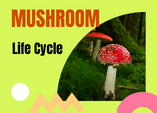Mushroom Life Cycle
Game Online
Mushroom Life Cycle Game Online . Biology lesson for students from 2nd to 7th grades to learn the stages in the life cycle of a mushroom.

The life cycle of a mushroom begins with the release of spores. The spore is one of the billions of tiny particles produced by the parent mushroom. They land close to the parent mushroom or far away, depending on wind conditions. If they land near the parent mushroom, they begin to germinate. Once they start germination, they divide by mitosis and produce a thread-like fiber called hypha.
The first stage in the mushroom's life cycle is called meiosis, which happens after the spores are released. The nuclei are not yet migrated into basidiospores, but are released from the gills in the underside of the cap. At this point, the mushroom begins its life cycle. The next stage is zygote 5a. Once the cap has developed, the spores release from gills.
The mushroom cap has a small cavity, and the hyphal knots begin to develop. The hyphal knots, also called primordia, form inside the cap. The hyphal knots are grouped together and grow into smooth, white bumps. The first flush of primordia begins with a single hyphal bud. At the end of this stage, a second flush of spores forms.
After the hyphal gills have formed, the roots of the mushroom grow inside the cap and release spores. The spores are released from the gills in the underside of the cap and begin the life cycle. If the conditions are favorable enough, the next stage of the mushroom's life cycle begins. It is the spores that begin the growth.
Each day, hundreds of thousands of spores are released from a single mushroom cap. While spores are too small to be seen by the naked eye, they travel over a long distance. They will germinate and spread their roots in the dirt. The spores will also divide into thread-like fibers called mycelium. Once they have finished this process, the mushrooms will begin to multiply.
After meiosis, the mushrooms divide into two sexes. The zygote, which is the only diploid stage, grows inside the cap and spores are released from the gills. The two sexes have different sexes and the life cycle of a mushroom begins with the release of spores.
The hyphae can donate or receive a haploid nucleus from each other. A hyphae can be either male or female. The haploid nucleus in the mycelium is the female. After the mycelium fusion, the two nuclei are side by side. The resulting mycelium cell is dikaryotic, meaning it contains two nuclei. The mycelium is the vegetative body of the fungus. The fungus will grow and expand in size to form a cap.
If you want to master the stages in the life cycle of a fungus, click and play the game above. Keep trying until you master all the stages. This game is for students from 2nd to 7th grades. Have fun learning online.
About Fungi: Yeast, mold, mushrooms, and lichens are all examples of fungi. These organisms are members of the eukaryotic kingdom. They live on Earth and help us maintain our ecosystem. But what exactly is a fungus? Read on to learn more. And if you're wondering what's so fun about them, keep reading. Here's what you should know. And why they're so interesting.
- Reproduction: Fungi reproduce asexually or sexually. Their reproductive structures are called sporangia and gametangia. Asexual reproduction occurs when the two reproductive nuclei are compatible. The vegetative body of fungi is the mycelium. This is a very variable structure with different types of hyphae. Some fungi have only one form of the mycelium.
- Sexual reproduction: The reproductive process of fungi results in the introduction of genetic variation into the population. It occurs in a variety of ways, including mating, and often in response to environmental conditions. The process of sexual reproduction varies between different species, but the end result is the same: two distinct sexes and two mating types. And the differences between the sexes are remarkable. The diversity and role of fungi is astounding!
- Diverse lifecycle: Most fungi reproduce in two ways. They can either be asexual or sexual. In the former case, the mycelium fragments into several separate individuals that grow on their own. In the latter case, the separate individuals fuse the hyphae of their new organism to produce a new individual. Moreover, asexual reproduction allows a large number of fungi to multiply rapidly.
